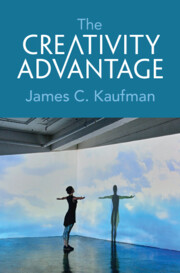309 results
The costs of curiosity and creativity: Minimizing the downsides while maximizing the upsides
-
- Journal:
- Behavioral and Brain Sciences / Volume 47 / 2024
- Published online by Cambridge University Press:
- 21 May 2024, e105
-
- Article
- Export citation
Part II - The Benefits of Creativity
-
- Book:
- The Creativity Advantage
- Published online:
- 27 July 2023
- Print publication:
- 29 June 2023, pp 81-146
-
- Chapter
- Export citation
Preface
-
- Book:
- The Creativity Advantage
- Published online:
- 27 July 2023
- Print publication:
- 29 June 2023, pp ix-xi
-
- Chapter
- Export citation
1 - To Define the Undefinable
- from Part I - The Basics of Creativity
-
- Book:
- The Creativity Advantage
- Published online:
- 27 July 2023
- Print publication:
- 29 June 2023, pp 3-18
-
- Chapter
- Export citation
7 - Healing
- from Part II - The Benefits of Creativity
-
- Book:
- The Creativity Advantage
- Published online:
- 27 July 2023
- Print publication:
- 29 June 2023, pp 96-112
-
- Chapter
- Export citation
Afterword
-
- Book:
- The Creativity Advantage
- Published online:
- 27 July 2023
- Print publication:
- 29 June 2023, pp 147-150
-
- Chapter
- Export citation
Copyright page
-
- Book:
- The Creativity Advantage
- Published online:
- 27 July 2023
- Print publication:
- 29 June 2023, pp iv-iv
-
- Chapter
- Export citation
Contents
-
- Book:
- The Creativity Advantage
- Published online:
- 27 July 2023
- Print publication:
- 29 June 2023, pp vii-viii
-
- Chapter
- Export citation
Part I - The Basics of Creativity
-
- Book:
- The Creativity Advantage
- Published online:
- 27 July 2023
- Print publication:
- 29 June 2023, pp 1-80
-
- Chapter
- Export citation
A Small Aperitif: The Evil Elephant
- from Part I - The Basics of Creativity
-
- Book:
- The Creativity Advantage
- Published online:
- 27 July 2023
- Print publication:
- 29 June 2023, pp 74-80
-
- Chapter
- Export citation
10 - Legacy
- from Part II - The Benefits of Creativity
-
- Book:
- The Creativity Advantage
- Published online:
- 27 July 2023
- Print publication:
- 29 June 2023, pp 137-146
-
- Chapter
- Export citation
Acknowledgments
-
- Book:
- The Creativity Advantage
- Published online:
- 27 July 2023
- Print publication:
- 29 June 2023, pp xii-xiv
-
- Chapter
- Export citation

The Creativity Advantage
-
- Published online:
- 27 July 2023
- Print publication:
- 29 June 2023
Index
-
- Book:
- The Creativity Advantage
- Published online:
- 27 July 2023
- Print publication:
- 29 June 2023, pp 197-200
-
- Chapter
- Export citation
3 - How Everyday Magic Works
- from Part I - The Basics of Creativity
-
- Book:
- The Creativity Advantage
- Published online:
- 27 July 2023
- Print publication:
- 29 June 2023, pp 31-45
-
- Chapter
- Export citation
2 - From Tiny to Small
- from Part I - The Basics of Creativity
-
- Book:
- The Creativity Advantage
- Published online:
- 27 July 2023
- Print publication:
- 29 June 2023, pp 19-30
-
- Chapter
- Export citation
Dedication
-
- Book:
- The Creativity Advantage
- Published online:
- 27 July 2023
- Print publication:
- 29 June 2023, pp v-vi
-
- Chapter
- Export citation
References
-
- Book:
- The Creativity Advantage
- Published online:
- 27 July 2023
- Print publication:
- 29 June 2023, pp 151-196
-
- Chapter
- Export citation
4 - Stumbling toward Genius
- from Part I - The Basics of Creativity
-
- Book:
- The Creativity Advantage
- Published online:
- 27 July 2023
- Print publication:
- 29 June 2023, pp 46-60
-
- Chapter
- Export citation
9 - Drive
- from Part II - The Benefits of Creativity
-
- Book:
- The Creativity Advantage
- Published online:
- 27 July 2023
- Print publication:
- 29 June 2023, pp 125-136
-
- Chapter
- Export citation



